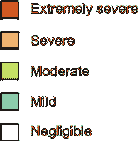
 |
The following map of the atmospheric corrosivity measured in Brazil was adapted from "Atmospheric Corrosion of Copper in Ibero-America" by M. Morcillo, E. Almeida, M. Marrocos, and B. Rosales, Corrosion, Vol. 57, No. 11, pages 967-980.


Air Pollution Air pollution in Brazil is mainly due to rapid urbanization in several cities that lacked the infrastructure to support rapid population growth. A recent World Bank study ranked the Brazilian cities Sao Paulo, Rio de Janeiro, Belo Horizonte and Curitiba as the four most polluted cities in the country.
The city of Curitiba has taken a unique approach in assuring that development can occur without adversely affecting the environment. Curitiba was one of the fastest growing cities in Brazil in the 1970's. The local government responded to pollution problems through initiatives aimed at shaping how and where growth could occur. Thus, although population has doubled since 1974, traffic has decreased by approximately 30%. The main goal of Curitiba's government was to reduce the population's reliance on cars. World famous innovations include dedicated busways, extra large buses for high density routes, tube shaped waiting areas where passenger fares can be paid in advance (similar to a subway system), and a major road network radiating out from the edge of the central city pedestrian zone. As a result of these innovations, Curitiba has reduced its consumption of fossil fuels and reduced air pollution.
Sao Paulo, Latin America's second largest city (behind Mexico City), experiences the same problems that many other large cities face when the population grows faster than the infrastructure to support it. Traffic congestion and pollution are two major problems affecting Sao Paulo. In 1989, 50% of city smog resulted from factories and 50% from motor vehicle emissions. In 1999, the percentages were 10% and 90% respectively. The same year, the local government instituted a pollution control program, whereby motorists are required to leave their vehicles at home one day a week. This system has reduced the volume of cars and cut daily emissions of carbon monoxide by at least 550 tons.
Sao Paulo's pollution levels are fueled by poor infrastructure design, gasoline prices that are among the lowest in the world and inefficient automobiles. Government initiatives to improve environmental conditions in Sao Paulo include plans for an orbital motorway (expected to reduce city traffic by 20%), additional metro lines, and improvements to the rail system by 2002. (reference)
Other regions and countries: Argentina, Brazil, Canada, Central America, Chile, China, Colombia, Cuba, France, Germany, India, Italy, Japan, Mexico, New Zealand, North America, Portugal, Russia, Saudi Arabia, South Africa, Spain, Sweden, UK, USA, Venezuela
 |
 |